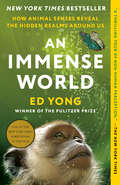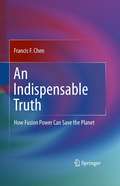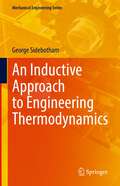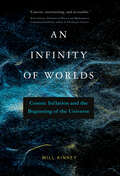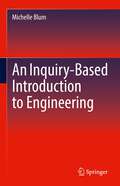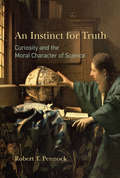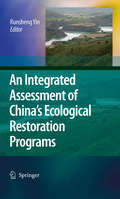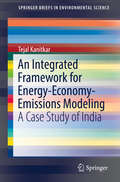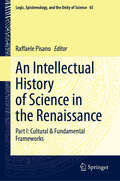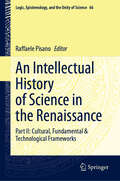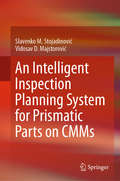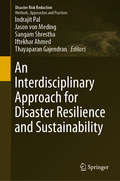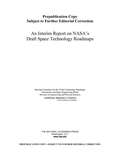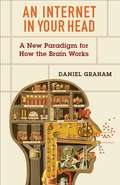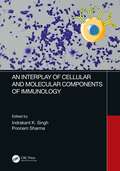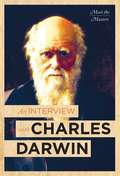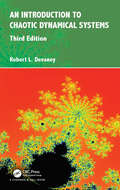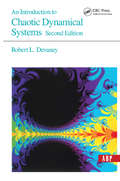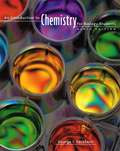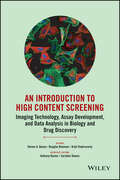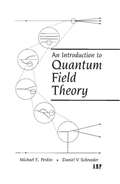- Table View
- List View
An Immense World: How Animal Senses Reveal the Hidden Realms Around Us
by Ed YongNEW YORK TIMES BESTSELLER <P><P> A “thrilling” (The New York Times), “dazzling” (The Wall Street Journal) tour of the radically different ways that animals perceive the world that will fill you with wonder and forever alter your perspective, by Pulitzer Prize–winning science journalist Ed Yong. <BR> “One of this year’s finest works of narrative nonfiction.”—Oprah Daily <BR> ONE OF THE TEN BEST BOOKS OF THE YEAR: The Wall Street Journal, The New York Times, Time, People, The Philadelphia Inquirer, Slate, Reader’s Digest, Chicago Public Library, Outside, Publishers Weekly, BookPage <BR> ONE OF THE BEST BOOKS OF THE YEAR: Oprah Daily, The New Yorker, The Washington Post, The Guardian, The Economist, Smithsonian Magazine, Prospect (UK), Globe & Mail, Esquire, Mental Floss, Marginalian, She Reads, Kirkus Reviews, Library Journal <BR> A KIRKUS REVIEWS BEST NONFICTION BOOK OF THE CENTURY <P><P> The Earth teems with sights and textures, sounds and vibrations, smells and tastes, electric and magnetic fields. But every kind of animal, including humans, is enclosed within its own unique sensory bubble, perceiving but a tiny sliver of our immense world. In An Immense World, Ed Yong coaxes us beyond the confines of our own senses, allowing us to perceive the skeins of scent, waves of electromagnetism, and pulses of pressure that surround us. We encounter beetles that are drawn to fires, turtles that can track the Earth’s magnetic fields, fish that fill rivers with electrical messages, and even humans who wield sonar like bats. We discover that a crocodile’s scaly face is as sensitive as a lover’s fingertips, that the eyes of a giant squid evolved to see sparkling whales, that plants thrum with the inaudible songs of courting bugs, and that even simple scallops have complex vision. We learn what bees see in flowers, what songbirds hear in their tunes, and what dogs smell on the street. We listen to stories of pivotal discoveries in the field, while looking ahead at the many mysteries that remain unsolved. <P><P> Funny, rigorous, and suffused with the joy of discovery, An Immense World takes us on what Marcel Proust called “the only true voyage . . . not to visit strange lands, but to possess other eyes.” <P><P> WINNER OF THE ANDREW CARNEGIE MEDAL • FINALIST FOR THE KIRKUS PRIZE • FINALIST FOR THE NATIONAL BOOK CRITICS CIRCLE AWARD • LONGLISTED FOR THE PEN/E.O. WILSON AWARD
An Indispensable Truth: How Fusion Power Can Save the Planet
by Francis F. ChenRecent books have raised the public consciousness about the dangers of global warming and climate change. This book is intended to convey the message that there is a solution. The solution is the rapid development of hydrogen fusion energy. This energy source is inexhaustible and, although achieving fusion energy is difficult, the progress made in the past two decades has been remarkable. The physics issues are now understood well enough that serious engineering can begin.The book starts with a summary of climate change and energy sources, trying to give a concise, clear, impartial picture of the facts, separate from conjecture and sensationalism. Controlled fusion -- the difficult problems and ingenious solutions -- is then explained using many new concepts.The bottom line -- what has yet to be done, how long it will take, and how much it will cost -- may surprise you. Francis F. Chen's career in plasma has extended over five decades. His textbook Introduction to Plasma Physics has been used worldwide continuously since 1974. He is the only physicist who has published significantly in both experiment and theory and on both magnetic fusion and laser fusion. As an outdoorsman and runner, he is deeply concerned about the environment. Currently he enjoys bird photography and is a member of the Audubon Society.
An Inductive Approach to Engineering Thermodynamics (Mechanical Engineering Series)
by George SidebothamThis textbook provides an alternative, inductive treatment of traditional Engineering Thermodynamics, e.g. energy and its transformations in engineering systems, and introduces the notion of eXergy. The book begins with energy methods developed in mechanics and transitions to thermodynamics by introducing both 1st and 2nd Laws of Thermodynamics immediately, incorporating more-advanced concepts using practical applications. This methodology continues throughout the text, wherein consideration of a specific example leads to general conclusions. At the same time, the author introduces eXergy, also called “Availability,” a measure of the potential of a substance to produce useful mechanical work in being brought from its current state to the conditions of the local environment.The book facilitates students’ understanding with workshop problem statements and guided spreadsheet.It is appropriate for a sophomore- or junior-level first course in thermodynamics and is restricted to “simple compressible substances” with no formal chemical reaction development. Mechanical engineering applications are the primary target, where several follow-up courses would follow (fluid mechanics, heat transfer, and a 2nd thermos course). Civil or electrical engineering students could benefit from just this course, and chemical engineering programs could develop chemically reacting and non-ideal applications in follow-up courses.
An Infinity of Worlds: Cosmic Inflation and the Beginning of the Universe
by Will KinneyWhat happened before the primordial fire of the Big Bang: a theory about the ultimate origin of the universe.In the beginning was the Big Bang: an unimaginably hot fire almost fourteen billion years ago in which the first elements were forged. The physical theory of the hot nascent universe—the Big Bang—was one of the most consequential developments in twentieth-century science. And yet it leaves many questions unanswered: Why is the universe so big? Why is it so old? What is the origin of structure in the cosmos? In An Infinity of Worlds, physicist Will Kinney explains a more recent theory that may hold the answers to these questions and even explain the ultimate origins of the universe: cosmic inflation, before the primordial fire of the Big Bang. Kinney argues that cosmic inflation is a transformational idea in cosmology, changing our picture of the basic structure of the cosmos and raising unavoidable questions about what we mean by a scientific theory. He explains that inflation is a remarkable unification of inner space and outer space, in which the physics of the very large (the cosmos) meets the physics of the very small (elementary particles and fields), closing in a full circle at the first moment of time. With quantum uncertainty its fundamental feature, this new picture of cosmic origins introduces the possibility that the origin of the universe was of a quantum nature. Kinney considers the consequences of eternal cosmic inflation. Can we come to terms with the possibility that our entire observable universe is one of infinitely many, forever hidden from our view?
An Inquiry-Based Introduction to Engineering
by Michelle BlumThe text introduces engineering to first-year undergraduate students using Inquiry-Based Learning (IBL). It draws on several different inquiry-based instruction types such as confirmation inquiry, structured inquiry, guided inquiry, and open inquiry, and all of their common elements. Professor Blum’s approach emphasizes the student’s role in the learning process, empowering them in the classroom to explore the material, ask questions, and share ideas, instead of the instructor lecturing to passive learners about what they need to know. Beginning with a preface to IBL, the book is organized into three parts, each consisting of four to ten chapters. Each chapter has a dedicated topic where an initial few paragraphs of introductory or fundamental material are provided. This is followed by a series of focused questions that guide the students’ learning about the concept(s) being taught. Featuring multiple inquiry-based strategies, each most appropriate to the topic, An Inquiry-Based Approach to Introduction to Engineering stands as an easy to use textbook that quickly allows students to actively engage with the content during every class period.
An Instinct for Truth: Curiosity and the Moral Character of Science (The\mit Press Ser.)
by Robert T. PennockAn exploration of the scientific mindset—such character virtues as curiosity, veracity, attentiveness, and humility to evidence—and its importance for science, democracy, and human flourishing.Exemplary scientists have a characteristic way of viewing the world and their work: their mindset and methods all aim at discovering truths about nature. In An Instinct for Truth, Robert Pennock explores this scientific mindset and argues that what Charles Darwin called “an instinct for truth, knowledge, and discovery” has a tacit moral structure—that it is important not only for scientific excellence and integrity but also for democracy and human flourishing. In an era of “post-truth,” the scientific drive to discover empirical truths has a special value.Taking a virtue-theoretic perspective, Pennock explores curiosity, veracity, skepticism, humility to evidence, and other scientific virtues and vices. He explains that curiosity is the most distinctive element of the scientific character, by which other norms are shaped; discusses the passionate nature of scientific attentiveness; and calls for science education not only to teach scientific findings and methods but also to nurture the scientific mindset and its core values.Drawing on historical sources as well as a sociological study of more than a thousand scientists, Pennock's philosophical account is grounded in values that scientists themselves recognize they should aspire to. Pennock argues that epistemic and ethical values are normatively interconnected, and that for science and society to flourish, we need not just a philosophy of science, but a philosophy of the scientist.
An Integrated Assessment of China’s Ecological Restoration Programs
by Runsheng YinChina has been undertaking unprecedented ecological restoration efforts to deal with its problems of soil erosion, flooding, dust storms, and habitat loss. While there have been studies of these efforts, questions remain concerning whether they have been effectively implemented, what their induced socioeconomic and ecological impacts are, and how their performance can be improved. Tackling these important questions in an integrated manner, "An Integrated Assessment of China's Ecological Restoration Programs" is extraordinary for its broad coverage and methodological rigor. It provides a substantial improvement over the conventional approach of simply reporting projects undertaken and accepting uncritically the government assessment, and thus fills an important knowledge gap of the restoration efforts being implemented upon a variety of ecosystems in China.
An Integrated Framework for Energy-Economy-Emissions Modeling: A Case Study of India (SpringerBriefs in Environmental Science)
by Tejal KanitkarThis book combines three different energy-economy-emissions modeling methodologies into one Integrated Modeling Framework (IMF) in an attempt to fill gaps in current modeling research as it applies to developing countries. Through the analysis of existing mathematical models, including large macro-economic models and technology-explicit energy models, the work proposes planning methodologies for developing countries that face challenges on their economy and infrastructure due to climate change. The three modeling methodologies discussed in the chapters are a decomposition analysis of trends in emissions intensity of GDP, linear programming techniques to determine optimum energy supply pathways given various resource and emissions constraints, and an input-output analysis to evaluate the impact of energy policies on income and equity. After a brief introduction to the history of the development of energy studies and the linkages between energy, economic, and environmental systems, the book delves into the component methodologies of the IMF and their intended outcomes. The decomposition analysis is intended to gauge the energy intensity of GDP and the structural composition of the economy to provide a basis on which scenarios are constructed in the following two methodologies. The linear programs are meant to develop a methodology to determine energy options under a variety of scenarios that capture the technical and economic characteristics of the power sector of developing countries. Lastly, the input-output analysis aims to build a methodology through which energy policy decisions can be understood and quantified to ensure the best possible impacts on developing economies and societies. Those who will be interested in this book include policy makers, academics, and students and professionals working on energy studies and energy-economy modeling.
An Integrated Modelling Approach to Design Cost-Effective AES for Agricultural Soil Erosion and Water Pollution: An Application of a Real Watershed in China
by Zhengzheng HaoAgri-environment schemes (AES) is frequently adopted for tricky environmental issues. One key concern for AES design is to optimize the cost-effectiveness. For issues of cost-effective prevention of agricultural soil erosion and non-point source water pollution, although models that assess both environmental effects and economic costs of land use measures have been developed, they typically adopt a planning perspective instead of designing AES with the role of farmers being considered. This book presents a spatially explicit novel integrated modelling approach that addresses the shortcoming by combining several components. The relevance of the modelling approach is demonstrated in this book by applying it to the Baishahe watershed in Shanxi province in China. The results show that the modelling approach is robust to design cost-effective AES, i.e. under given budget the maximum environmental effect in the study region could be attained with a set of designed payments for measures in AES. The developed modelling approach is generic and powerful for application in all kinds of agricultural watersheds with various sizes.
An Integrative Approach to Successional Dynamics
by Meiners, Scott J. and Pickett, Steward T. A. and Cadenasso, Mary L. Scott J. Meiners Pickett, Steward T. A. Mary L. CadenassoMuch of what is considered conventional wisdom about succession is not as clear cut as it is generally believed. Yet, the importance of succession in ecology is undisputed since it offers a real insight into the dynamics and structure of all plant communities. Part monograph and part conceptual treatise, An Integrative Approach to Successional Dynamics presents a unifying conceptual framework for dynamic plant communities and uses a unique long-term data set to explore the utility of that framework. The fourteen chapters, each written in a nontechnical style and accompanied by numerous illustrations and examples, cover diverse aspects of succession, including: community, population and disturbance dynamics, diversity, community assembly, heterogeneity, functional ecology and biological invasion. This unique text will be a great source of reference for researchers and graduate students in ecology and plant biology and others with an interest in the subject.
An Intellectual History of Science in the Renaissance: Part I: Cultural & Fundamental Frameworks (Logic, Epistemology, and the Unity of Science #65)
by Raffaele PisanoThis first of a two-part volume (Book I) deals with a unit intellectual cultural history of science in the Renaissance within fundamental frameworks. An intellectual cultural history of science examines how human and their intellectual experiences have been expressed in, and emerged by scientific ideas. Taking into account the excellence of the essays – which cover several branches and disciplines in history and epistemology of science – this book also provides perspectives on the enduring influence of a historiographical tradition, e.g., the emergence of fundamental works on mathematics and geometry, household&’s principal functions, food and culture, clock instrumentation, surgery as a practical branch of medicine. It describes the ways it differently accounted for variation in unlike countries and consequently how its results remain, still nowadays, a debated question, as well as due to constraints preventing an extensive exploration of its remarkable historiography. This volume gathers selected and double peer review contributions by historians of physics/mathematics/science as new fundamental perceptions in the history of science during the Renaissance, ranging across several fields of science within its intellectual and cultural history. The book is an accessible avenue to understanding cultural issues to develop scientific ideas by leading authorities who offer much-needed historical insights into the field of intellectual and fundamental history of science. It provides an absorbing and revealing read for historians, philosophers and scientists alike.
An Intellectual History of Science in the Renaissance: Part II: Cultural, Fundamental & Technological Frameworks (Logic, Epistemology, and the Unity of Science #66)
by Raffaele PisanoThis second of a two-part volume (Book II) extends the historical–scientific inquiry of first-part volume (Book I) by considering other specific case studies within cultural, fundamental & technological frameworks. An intellectual cultural history of science & technology examines how human and their applied sciences-experiences have been expressed in, and trained by ideas and technologies. The contributors explain ways in which the sciences allowed advanced modelling on the one hand, and the development of new technological ideas on the other hand, including methods and theories, institutions, engineering devices/instrumentation and social implications as well. Taking into account the excellence of the essays, the book covers several branches and disciplines in science & technology, e.g., theoretical mathematics and the empirical work, machinery and mechanisms, stored information, transportation, inquiring methods in history and historiography of science & technology. It describes the ways it differently accounted for variation in unlike contexts and consequently how its results remain, still nowadays, a debated question, as well as due to constraints preventing an extensive exploration of its remarkable historiography. The book gathers selected and double peer review contributions by historians of physics/mathematics/engineering/science as new perceptions of the history of science during the Renaissance ranging across several fields of science within its fundamental, cultural & technological history. The volume is an accessible avenue to understanding cultural ideas & technologies by leading authorities who offer much-needed historical insights into the field of and intellectual history of science & technology. It provides an absorbing and revealing read for historians, philosophers, and scientists alike.
An Intelligent Inspection Planning System for Prismatic Parts on CMMs
by Vidosav D. Majstorović Slavenko M. StojadinovićThis book examines an intelligent system for the inspection planning of prismatic parts on coordinate measuring machines (CMMs). The content focuses on four main elements: the engineering ontology, the model of inspection planning for prismatic parts on CMMs, the optimisation model of the measuring path based on an ant-colony approach, and the model of probe configuration and setup planning based on a genetic algorithm. The model of inspection planning for CMMs developed here addresses inspection feature construction, the sampling strategy, probe accessibility analysis, automated collision-free operation, and probe path planning. The proposed model offers a novel approach to intelligent inspection, while also minimizing human involvement (and thus the risk of human error) through intelligent planning of the probe configuration and part setup. The advantages of this approach include: reduced preparation times due to the automatic generation of a measuring protocol; potential optimisation of the measuring probe path, i.e., less time needed for the actual measurement; and increased planning process autonomy through minimal human involvement in the setup analysis and probe configuration.
An Interdependent Approach to Happiness and Well-Being
by Jeremy Rappleye Yukiko UchidaThis open access book examines an interdependent approach to happiness and well-being, one that contrasts starkly with dominant approaches that have originated from Western culture(s). It highlights the diversity of potential pathways towards happiness and well-being globally, and answers calls - voiced in the UN’s Sustainable Development Goals - for more socially and environmentally sustainable models.Leading global organizations including the OECD, UNICEF, and UNESCO are now proposing human happiness and well-being as a more sustainable alternative to a myopic focus on GDP growth. Yet, the definition of well-being offered by these organizations derives largely from the philosophies, social sciences, and institutional patterns of Europe and the United States. Across seven chapters this book carefully probes the inadequacy of these approaches to well-being globally and reveals the distorting effect this has on how we imagine our world, organize institutions, and plan our collective future(s). It shares a wealth of evidence and examples from across East Asia - a region where interdependence remains foregrounded - and concludes by provocatively arguing that interdependence may provide a more sustainable approach to happiness and well-being in the 21st century. A timely and accessible book, it offers fresh insights for scholars and policymakers working in the areas of psychology, health, sociology, education, international development, public policy, and philosophy.This is an open access book.
An Interdisciplinary Approach for Disaster Resilience and Sustainability (Disaster Risk Reduction)
by Sangam Shrestha Indrajit Pal Iftekhar Ahmed Jason Von Meding Thayaparan GajendranThis book includes selected papers presented at the international expert forum on “Mainstreaming Resilience and Disaster Risk Reduction in Education,” held at the Asian Institute of Technology, Thailand on 1–2 December 2017. The journey towards disaster risk reduction and resilience requires the participation of a wide array of stakeholders ranging from academics to policymakers, to disaster managers. Given the multifaceted and interdependent nature of disasters, disaster risk reduction and resilience require a multidisciplinary problem-solving approach and evidence-based techniques from the natural, social, engineering, and other relevant sciences.Traditionally, hazard and disaster-related studies have been dominated by the engineering and social science fields. In this regard, the main purpose of this book is to capture the multidisciplinary and multisectoral nature of disaster risk reduction, and to gather existing data, research, conceptual work, and practical cases regarding risk reduction and its ties to sustainable development under a single “umbrella.” Along with the sustainability aspect, the book also links disaster risk reduction with development, technology, governance, education, and climate change, and includes discussions on challenges, solutions, and best practices in the mainstreaming of disaster risk reduction.
An Interim Report on NASA's Draft Space Technology Roadmaps
by The National Academy of SciencesFor the National Aeronautics and Space Administration (NASA) to achieve many of its space science and exploration goals over the next several decades, dramatic advances in space technology will be necessary. NASA has developed a set of 14 draft roadmaps to guide the development of such technologies under the leadership of the NASA Office of the Chief Technologist (OCT). Each roadmap focuses on a particular technology area. OCT requested that the National Research Council conduct a study to review the draft roadmaps, gather and assess relevant community input, and make recommendations and suggest priorities to inform NASA's decisions as it finalizes its roadmaps. The success of OCT's technology development program is essential, because technological breakthroughs have long been the foundation of NASA's successes, from its earliest days, to the Apollo program, to a vast array of space science missions and the International Space Station. An Interim Report of NASA's Technology Roadmapidentifies some gaps in the technologies included in the individual roadmaps. The report suggests that the effectiveness of the NASA space technology program can be enhanced by employing proven management practices and principles including increasing program stability, addressing facility issues, and supporting adequate flight tests of new technologies. This interim report provides several additional observations that will be expanded on in the final report to be released in 2012.
An Internet in Your Head: A New Paradigm for How the Brain Works
by Daniel GrahamWhether we realize it or not, we think of our brains as computers. In neuroscience, the metaphor of the brain as a computer has defined the field for much of the modern era. But as neuroscientists increasingly reevaluate their assumptions about how brains work, we need a new metaphor to help us ask better questions.The computational neuroscientist Daniel Graham offers an innovative paradigm for understanding the brain. He argues that the brain is not like a single computer—it is a communication system, like the internet. Both are networks whose power comes from their flexibility and reliability. The brain and the internet both must route signals throughout their systems, requiring protocols to direct messages from just about any point to any other. But we do not yet understand how the brain manages the dynamic flow of information across its entire network. The internet metaphor can help neuroscience unravel the brain’s routing mechanisms by focusing attention on shared design principles and communication strategies that emerge from parallel challenges. Highlighting similarities between brain connectivity and the architecture of the internet can open new avenues of research and help unlock the brain’s deepest secrets.An Internet in Your Head presents a clear-eyed and engaging tour of brain science as it stands today and where the new paradigm might take it next. It offers anyone with an interest in brains a transformative new way to conceptualize what goes on inside our heads.
An Interplay of Cellular and Molecular Components of Immunology
by Poonam Sharma Indrakant K. SinghOur immune system defends us against infection by employing multiple lines of defense. The relevance of the immune response in human health, disease prevention, and vaccinations becomes evident when the immune system is compromised as in the case of pathogenic infections or autoimmune diseases. The reader will gain a fundamental understanding of the essential principles of immunology, such as how our immune system recognizes/fights infectious agents, how our body differentiates between foreign and self-cells/molecules, and how the memory from previous infections aids in a faster and more effective immune response. The book is divided into 17 chapters, providing an overview of the immune system and its components, including its organs and cells. Chapters on the major histocompatibility complex, the complement system, hypersensitivity and tolerance, antibody diversity through DNA rearrangements, and autoimmune diseases are included in the book which further broadens the understanding of this very complex system of our body. Chapters on transplantation immunology and vaccines provide a perspective on the application of these immunological concepts and will be of great interest to readers. Key features of the book: Simple, direct, and lucid language Comprehensive coverage of concepts for better understanding Well-labeled illustrations, flowcharts, and tables for enhanced learning Every chapter is followed up with a detailed summary and questionnaire A detailed glossary for users to know the right words Chapters contributed/reviewed by experienced experts in this field The book provides broad, accessible, and up-to-date information about immunological perspectives to biotechnologists, biomedical scientists, biochemists, molecular biologists, and students from various streams of life sciences, including zoology, biotechnology, and microbiology, as well as instant access to a wealth of information.
An Interview With Charles Darwin
by Peter J. BowlerCharles Darwin was a nineteenth century English naturalist responsible for several advancements in evolutionary theory. This is a biography for a young audience.
An Introduction To Chaotic Dynamical Systems
by Robert L. DevaneyThere is an explosion of interest in dynamical systems in the mathematical community as well as in many areas of science. The results have been truly exciting: systems which once seemed completely intractable from an analytic point of view can now be understood in a geometric or qualitative sense rather easily. Scientists and engineers realize the power and the beauty of the geometric and qualitative techniques. These techniques apply to a number of important nonlinear problems ranging from physics and chemistry to ecology and economics. Computer graphics have allowed us to view the dynamical behavior geometrically. The appearance of incredibly beautiful and intricate objects such as the Mandelbrot set, the Julia set, and other fractals have really piqued interest in the field. This is text is aimed primarily at advanced undergraduate and beginning graduate students. Throughout, the author emphasizes the mathematical aspects of the theory of discrete dynamical systems, not the many and diverse applications of this theory. The field of dynamical systems and especially the study of chaotic systems has been hailed as one of the important breakthroughs in science in the past century and its importance continues to expand. There is no question that the field is becoming more and more important in a variety of scientific disciplines. New to this edition: •Greatly expanded coverage complex dynamics now in Chapter 2•The third chapter is now devoted to higher dimensional dynamical systems.•Chapters 2 and 3 are independent of one another.•New exercises have been added throughout.
An Introduction To Chaotic Dynamical Systems (Studiea In Nonlinearity Ser.)
by Robert DevaneyThe study of nonlinear dynamical systems has exploded in the past 25 years, and Robert L. Devaney has made these advanced research developments accessible to undergraduate and graduate mathematics students as well as researchers in other disciplines with the introduction of this widely praised book. In this second edition of his best-selling text, Devaney includes new material on the orbit diagram fro maps of the interval and the Mandelbrot set, as well as striking color photos illustrating both Julia and Mandelbrot sets. This book assumes no prior acquaintance with advanced mathematical topics such as measure theory, topology, and differential geometry. Assuming only a knowledge of calculus, Devaney introduces many of the basic concepts of modern dynamical systems theory and leads the reader to the point of current research in several areas.
An Introduction To Chemistry For Biology Students
by George I. Sackheim<p>Introduction to Chemistry for Biology Students, Ninth Edition is a unique workbook that uses a step-by-step approach to teach students the chemistry necessary for success in life sciences courses. <p>Today's biology courses place an increasing emphasis on the chemical processes that underlie critical biological functions. This text helps students review and master all the basic facts, concepts, and terminology of chemistry that they need to understand those processes and to excel in their life science courses.
An Introduction To Design Of Experiments: A Simplified Approach
by Larry B. BarrentineAre you aware of how design of experiments can positively effect your work? Have you been avoiding DOE due to its mathematical structure? Now there is a tool that explains the basics of DOE with little mathematical know-how while maintaining statistical correctness. By minimizing DOE's mathematics in favor of a logical, structured approach, the author demonstrates that nearly anyone can adapt DOE to their needs. You'll find yourself working through the book in a step-by-step manner allowing you to immediately apply what you've learned to your own situation. Each procedure is illustrated by an example. Case studies and exercises guide you through the book to help you evaluate your understanding before moving ahead to another section. A glossary of common DOE terms is also included making this one of the most thorough, basic, introductions to this useful tool
An Introduction To High Content Screening
by Douglas Bowman Anthony Davies Steven A. Haney Arijit Chakravarty Caroline ShamuUsing a collaborative and interdisciplinary author base withexperience in the pharmaceutical industry and academia, this bookis a practical resource for high content (HC) techniques.* Instructs readers on the fundamentals of highcontent screening (HCS) techniques* Focuses on practical and widely-used techniques likeimage processing and multiparametric assays* Breaks down HCS into individual modules for trainingand connects them at the end* Includes a tutorial chapter that works through sampleHCS assays, glossary, and detailed appendices
An Introduction To Quantum Field Theory
by Michael E. Peskin Daniel V. SchroederAn Introduction to Quantum Field Theoryis a textbook intended for the graduate physics course covering relativistic quantum mechanics, quantum electrodynamics, and Feynman diagrams. The authors make these subjects accessible through carefully worked examples illustrating the technical aspects of the subject, and intuitive explanations of what is going on behind the mathematics. After presenting the basics of quantum electrodynamics, the authors discuss the theory of renormalization and its relation to statistical mechanics, and introduce the renormalization group. This discussion sets the stage for a discussion of the physical principles that underlie the fundamental interactions of elementary particle physics and their description by gauge field theories.
